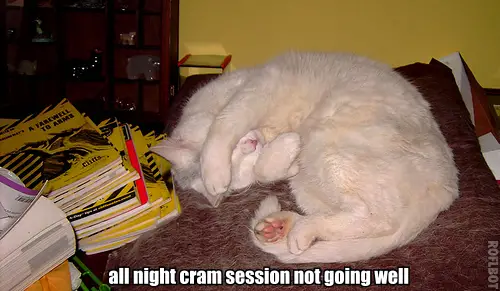Memes are a relatively new idea that describes a very familiar concept. Memes are like cultural genes. They transmit cultural information and ideas through speech, gestures, and writing. Memes can also be contagious and sweep through a population, such as the earworm. Merely reading that the Macarena is an example of the contagious earworm is enough to have that damn music start running through your head. You may not remember all the words, or the dance, but, oh, you remember the general tune and madness that went with the Macarena.
It’s cousin is the internet meme, those silly things that sweep the internet sporadically. Internet memes are notoroious for mating with other memes and mutating into new forms. Memes combine and mutate offline as well, but mass medias spreads them faster and the interent sends the rate of transmission to warp speed. The internet meme probably most familiar to even inexperienced internet users is the LOLcat.

Internet memes appear to spontaneously appear out of nowhere, but even the Lolcat has a pedigree tied into original print media and constantly refers back to older memes. The idea of a picture of a cat with an amusing caption is hardly new. You can find whole books of them as soon as printing photos became economically feasible.
As soon as the photocopier became available, this type of picture was widely circulated through offices. Sometimes it appeared via fax machine. Virtually every break room had the many times photocopied picture of a cat hanging off a limb with some variation of “just hanging in there” as a caption through much of the 80s and 90s. The photocopier allowed some basic mutation of photos and text as you could cut and paste an image and text together, but you still had to GET the picture and use a fairly expensive (if relatively common) piece of office equipment to distribute it.
Of course publishers continued to churn those out these images on greeting cards, calenders, magazines, and books, but they were a lot more home made ones out there as well.
The internet just allowed them to be circulated more quickly and by a greater variety of people. Digital cameras also allowed people to quickly generate the necessary photos. The production cost fell through the floor and there were no gatekeepers to tell people NOT to do things. There are even websites that will do all the hard editing work. Just link to or upload a picture and type in the text! (such as ROFLBot, which was used in the photo above)
The internet version mutated and merged with the longstanding literary tradition that animals are terrible typists (see The Silent Meow by Paul Gallico or The Bunnicula series by James Howe) and spawned the LOLcat we all know and love. The LOL part refers to early internetism of LOL, which was short for Laughing Out Loud. It was just faster to type and is now widely used in text messages. But you still need to know what the abbreviation itself stands for to even understand the name of the meme itself.
